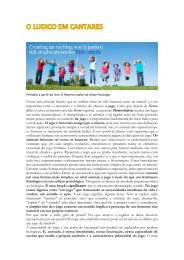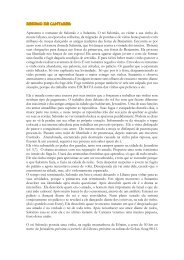Motherhood in Childhood
Create successful ePaper yourself
Turn your PDF publications into a flip-book with our unique Google optimized e-Paper software.
t Girls <strong>in</strong> Rajasthan,<br />
India learn<strong>in</strong>g<br />
to read.<br />
© Mark Tuschman/<br />
Educate Girls India<br />
violence, regardless of the perpetrator (Center for<br />
Reproductive Rights, 2009).<br />
The ICPD Programme of Action recognizes<br />
that one of the cornerstones of population and<br />
development-related programmes is elim<strong>in</strong>at<strong>in</strong>g<br />
all forms of violence aga<strong>in</strong>st women, <strong>in</strong>clud<strong>in</strong>g<br />
sexual abuse and violence aga<strong>in</strong>st children and<br />
adolescents (ICPD, Pr<strong>in</strong>ciples 4 and 11).<br />
School, peers, partners<br />
School<br />
The longer girls stay <strong>in</strong> school, the more likely<br />
they are to use contraception and prevent pregnancy<br />
and the less likely they are to marry young<br />
(Lloyd, 2006; UNICEF, 2006; Lloyd and Young,<br />
2009). Girls who are not <strong>in</strong> school are more<br />
likely to get pregnant than those rema<strong>in</strong><strong>in</strong>g <strong>in</strong><br />
school, whether or not they are married.<br />
The Secretariat of the 65th World Health<br />
Assembly <strong>in</strong> 2012 called education “a major<br />
protective factor for early pregnancy: the more<br />
years of school<strong>in</strong>g the fewer early pregnancies,”<br />
add<strong>in</strong>g that “birth rates among women with low<br />
education are higher than those with secondary<br />
or tertiary education.”<br />
While the correlation between educational<br />
atta<strong>in</strong>ment and lower rates of adolescent pregnancy<br />
is well documented, the direction of<br />
causality and the sequenc<strong>in</strong>g are still the subject<br />
of some debate, as noted <strong>in</strong> the previous chapter.<br />
In many countries, early school-leav<strong>in</strong>g is<br />
attributed to adolescent pregnancy; however,<br />
pregnancy and early marriage are more likely<br />
to be consequences rather than causes of early<br />
school leav<strong>in</strong>g. Once girls have left school, pregnancy<br />
and/or marriage are likely to follow <strong>in</strong><br />
short order (Lloyd and Young, 2009).<br />
Educational atta<strong>in</strong>ment and sexual and reproductive<br />
transitions are closely related <strong>in</strong> that a<br />
pregnancy or an early marriage can derail a girl’s<br />
school<strong>in</strong>g. As boys typically marry later than<br />
girls and do not face the same risks and responsibilities<br />
associated with pregnancy, their sexual<br />
maturation and behaviour do not have the<br />
potential to <strong>in</strong>terfere with their school progress<br />
<strong>in</strong> the same way (Lloyd and Young, 2009).<br />
A 2012 study provides evidence that <strong>in</strong>terventions<br />
that encourage school attendance are<br />
effective <strong>in</strong> reduc<strong>in</strong>g overall adolescent fertility,<br />
mak<strong>in</strong>g a case for expand<strong>in</strong>g educational<br />
opportunities for girls and creat<strong>in</strong>g <strong>in</strong>centives<br />
for school cont<strong>in</strong>uation (McQueston et al.,<br />
2012). Enabl<strong>in</strong>g or encourag<strong>in</strong>g girls to attend<br />
42 CHAPTER 3: PRESSURES FROM MANY DIRECTIONS

















